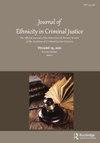纽约警察局(NYPD)的警察世界观、无意识偏见及其对种族和民族差异的潜在贡献因“偷偷摸摸的行动”而停止。
IF 1
Q3 CRIMINOLOGY & PENOLOGY
引用次数: 12
摘要
在Floyd等人诉纽约市案(2013年)中,联邦地区法院法官裁定,纽约警察局(NYPD)针对主要是黑人和拉丁裔的纽约人采取了违宪的拦截搜身措施。在Floyd(2013)案中做出的主要决定中,法官认为“偷窥运动”是建立合理怀疑的弱指标,需要为Terry停车辩护。此外,法官认识到,“潜行”是一个模糊和主观的术语,可能受到无意识偏见的影响,导致停止结果的种族和民族差异。基于法官对无意识偏见的关注,目前的研究试图(1)提供一个理论框架来理解警察的世界观是如何促成或与无意识偏见相互作用的;(2)检查纽约警察局的警察是否更有可能因为“偷情运动”而阻止黑人和西班牙裔纽约人。后一项调查使用了纽约警察局2011年、2013年和2016年的拦截搜身数据。本研究的社会科学意义为(1)法官对警察拦截的恐惧基于隐蔽的手势和(2)法院命令干预的有效性提供了支持。本文章由计算机程序翻译,如有差异,请以英文原文为准。
Police worldviews, unconscious bias, and their potential to contribute to racial and ethnic disparities in New York Police Department (NYPD) stops for reason of “furtive movement”
Abstract In Floyd et al. v The City of New York (2013), the federal district court judge ruled that the New York Police Department (NYPD) was engaging in unconstitutional stop-and-frisk practices that targeted predominately Black and Latino New Yorkers. Among the major decisions made in Floyd (2013), the judge identified “Furtive Movement” as being a weak indicator for establishing the reasonable suspicion needed to justify a Terry stop. Moreover, the judge recognized that “Furtive Movement” is a vague and subjective term, which may be affected by unconscious bias and lead to racial and ethnic disparities in stop outcomes. Building on the judge’s concern about unconscious bias, the current study attempts to (1) provide a theoretical framework for understanding how police officers’ worldview may contribute to or interact with unconscious biases and to (2) examine whether NYPD officers are more likely to stop Black and Hispanic New Yorkers than their White counterparts for the reason of “Furtive Movement.” The latter inquiry is explored using NYPD stop-and-frisk data from 2011, 2013, and 2016. The social scientific implications of this research provide support for (1) the judge’s apprehension toward police stops on the basis of furtive gestures and (2) the effectiveness of court-ordered intervention.
求助全文
通过发布文献求助,成功后即可免费获取论文全文。
去求助
来源期刊

Journal of Ethnicity in Criminal Justice
CRIMINOLOGY & PENOLOGY-
CiteScore
1.70
自引率
16.70%
发文量
16
期刊介绍:
The Journal of Ethnicity in Criminal Justice explores the prejudice that currently affects our judicial system, our courts, our prisons, and our neighborhoods all around the world. This unique multidisciplinary journal is the only publication that focuses exclusively on crime, criminal justice, and ethnicity/race. Here you"ll find insightful commentaries, position papers, and examinations of new and existing legislation by scholars and professionals committed to the study of ethnicity and criminal justice. In addition, the Journal of Ethnicity in Criminal Justice presents the latest empirical findings, theoretical discussion, and research on social and criminal justice issues.
 求助内容:
求助内容: 应助结果提醒方式:
应助结果提醒方式:


